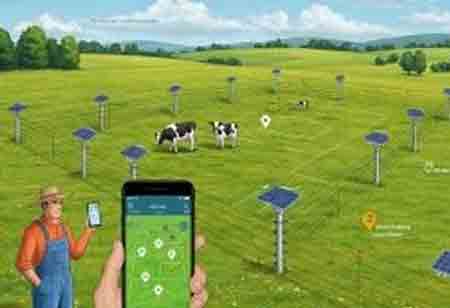Thank you for Subscribing to Agri Business Review Weekly Brief
Innovative Livestock Management: The Benefits of Digital Fencing Systems

By
Agri Business Review | Monday, June 30, 2025
Stay ahead of the industry with exclusive feature stories on the top companies, expert insights and the latest news delivered straight to your inbox. Subscribe today.
The global demand for food, particularly animal protein, is rising, leading the agricultural industry to face new challenges and opportunities. An innovative solution gaining traction is the digital livestock fence system, which offers a modern approach to managing and safeguarding cattle. This system shifts from traditional physical barriers, such as barbed wire, as farmers seek more efficient and sustainable alternatives that enhance productivity while minimizing environmental impact.
The crux of digital livestock fencing’s growing popularity is the demand for sustainable agricultural methods. Farmers are pressured to reduce their ecological footprint as environmental consciousness increases while still generating profit. Traditional fencing methods can contribute to deforestation and are often costly and labor-intensive due to the materials required, such as wood and metal. In contrast, digital livestock fences provide an innovative solution that utilizes wireless technology, like GPS and cellular networks, to establish virtual boundaries for cattle.
These systems allow farmers to monitor and manage their livestock without the physical barriers that can disrupt natural habitats, resulting in less resource use and a smaller environmental impact. Moreover, digital fencing systems offer adaptability that aligns well with contemporary farming practices. Using technology, farmers can set up fences quickly and adjust them as needed, allowing for more dynamic management of grazing areas. This flexibility is crucial in an ever-changing agricultural landscape where farmers must respond swiftly to varying conditions and market demands.
Technological Advancements Transforming Livestock Management
Technological advancements have been pivotal in rapidly adopting digital livestock fence systems. Livestock management has been transformed by integrating sensors, GPS, and real-time monitoring tools. With these technologies, farmers can track the movement of their animals, prevent them from straying too far, and respond quickly to potential dangers. This proactive monitoring reduces the risk of livestock loss, thereby increasing farm productivity.
Furthermore, the data generated from these digital systems can provide invaluable insights into herd health and behavior. By analyzing this information, farmers can make informed decisions to improve their operations, leading to more efficient resource utilization and better animal welfare. The capacity to manage herds remotely and in real-time ensures that farmers are well-equipped to address any challenges they may encounter, ultimately leading to a more streamlined agricultural process.
Challenges and Barriers to Adoption
Despite the numerous advantages that digital livestock fencing offers, several significant challenges impede widespread adoption. One of the foremost concerns is the initial implementation cost. The upfront investment required for installing and maintaining these systems can be a barrier, particularly for smaller farms or those in developing countries. While the long-term benefits may outweigh these costs, many farmers hesitate to make a significant initial expenditure without assurance of return on investment.
Additionally, the complexity of these technologies necessitates proper training and support. Many farmers lack the technical skills to effectively install and manage digital fencing systems. Consequently, businesses in this sector strive to offer more affordable solutions and simplified systems. By providing financial options, education, and user-friendly interfaces, stakeholders hope to democratize access to these groundbreaking technologies.
The regulatory landscape surrounding digital livestock fencing is another factor influencing the industry’s growth. Like any other technology impacting agriculture, these systems must adhere to local animal welfare, data security, and environmental protection regulations. Some governments may restrict the types of technology permissible for animal management or require specific certifications for compliance. As a result, industry players must work collaboratively with authorities to ensure adherence to regulations while advocating for policies that support adopting technology in eco-friendly farming practices.
Meeting Consumer Demand for Ethical Practices
In recent years, consumer awareness regarding the ethical treatment of animals and the environmental implications of food production has surged. This changing landscape is prompting farmers to integrate technology into their operations that enhances productivity and aligns with conscientious consumers’ values. Digital livestock fencing systems provide a viable solution by allowing for better control of livestock movement and reducing reliance on physical barriers that can disturb ecosystems.
Moreover, the ability to enhance animal welfare through improved management practices resonates with a growing base of consumers committed to supporting ethically and sustainably produced food items. By increasing operational efficiency and lowering resource usage, digital fencing satisfies the demand for farming practices prioritizing environmental responsibility and humane treatment of animals. Ultimately, the digital cattle fence system has the potential to make a profound impact on both the environment and sustainable agriculture.
Traditional fencing often relies on materials that significantly harm the planet. In contrast, digital systems reduce the need for such materials while leveraging technology to minimize land alteration. These systems’ real-time data can also be instrumental in monitoring land use, promoting sustainable grazing practices, and preventing issues like overgrazing. Emphasizing sustainability and efficiency helps farmers succeed in an eco-conscious world. As these practices spread, they offer significant benefits for livestock management and the environment, fostering a sustainable agricultural future.





